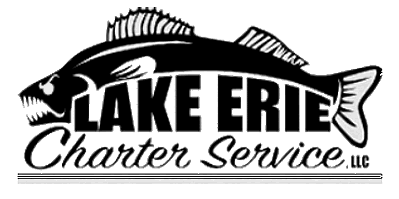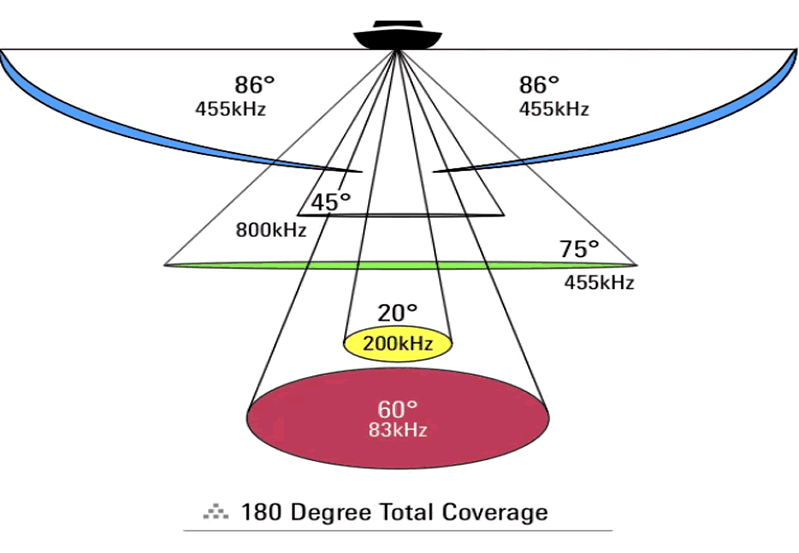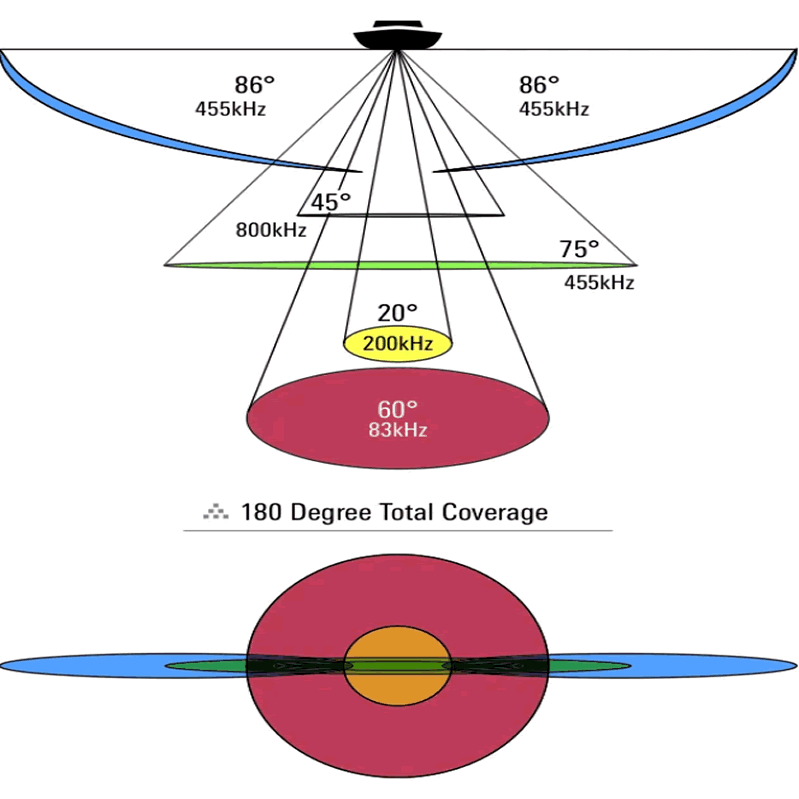Cone Angle
The transducer’s cone angle is an important thing to consider when using sonar. Generally, lower frequencies tend to use a wider angle, and higher frequencies use narrower angles. Every manufacturer is slightly different but for the most part, 83khz uses a 60-degree cone angle while 200khz is around 20 degrees.
This is important to understand because in 40-feet of water, a 60-degree cone will ‘read’ a bottom diameter of 40-feet (60-degree cone diameter is nearly equal to depth), and which is about 1250-square-feet of coverage area – while at 40-feet with a 20-degree cone will cover a diameter of about 1/3 the depth, making it a 13-ft diameter or 130-square-feet or coverage area.
As you can start to imagine this will make a big difference in how many fish your sonar unit is going to mark, just based on coverage area. There really isn’t an instance that I can think of on Lake Erie where I would want to run anything other than 200khz. It’s capable of marking fish in depths of up to 200-ft, and I don’t know about you but I’ve never caught a walleye that was 200-feet down.
Marking fish with a 20-degree cone – although it’s a fairly narrow cone – it can still be deceiving when you’re fishing depths that we often see on Lake Erie (40-60 feet or more). In 60-feet of water, the 20-degree cone is covering around a 20-foot diameter or a surface area of over 300 sq ft. The cone area halfway up the water column (or 30-feet down) would only be roughly half the area (30-ft).
If the fish were spread out evenly throughout all 60-feet of the water column, it would appear that there are nearly double the amount of fish marking on the screen at the bottom than halfway up and next to no fish near the surface. Just keep in mind that if you’re marking even just a few fish up high, it’s very possible that there are way more fish up high than your sonar is showing. Because the cone is so narrow that high up, the sample area is much smaller. You might also find that your marking most fish around 30-ft down but still have quite a few down lower. However, it’s more likely that you are being deceived by the sample size of the cone as it widens out down deeper and there are really way more fish around that 30-foot depth than there are down deeper.
Marking Fish at Cruising Speed
This is a very important part of being able to use your sonar efficiently to eliminate water. Lake Erie is way too vast to have to be at an idle to mark fish. You need to be able to mark fish while the boat is on plane. It’s really a fine art trying to get a sonar to work well at speed, and transducer placement is key. Some larger boats will use a through hull transducer with a fairing block, and even spacers to get the transducer under the turbulence caused by the strakes on the bottom of the boat.
I would recommend doing plenty of hours of research on your particular boat and type of transducer prior to drilling any holes. Possibly even adding a piece of mounting board to the transom to mount transducers on, so you can make adjustments or changes without punching a ton of holes in the boat. Consider hiring a professional to help you mount and adjust the transducer. Whatever you do, make sure you can mark fish at cruising speed.
Ghost Fish
We have had this scenario play out so many times we made a name for it. Here is how it goes. You’re running out and not really marking much, just a few fish up high but nothing crazy. You slow down to have a better look and hardly mark a single fish. Back on plane and you start to mark a few more up high but again not a ton of fish just a few.
Finally, it hits you the few fish you’re marking are the ones who didn’t get out of the way of the boat in time because they are not very deep in the water. They spook away from the boat and the coverage of your transducer is much narrower up high in the water column, making it harder to mark shallow fish. With such a small coverage area, when you slow down the fish have plenty of time to move off to the sides – so you don’t mark hardly ANY. You stop and set a few lines with short leads putting your baits less than 10-feet down and BAM – it’s fish after fish, all the while you’re not marking a single fish with the sonar but catching them on the rods.
Even on days when you are marking good numbers of fish down lower, it’s always a good idea to set a few lines up way higher than you would think they should be just to keep them honest.
Fish On The Bottom
Your sonar unit is not generally going to show you fish that are sitting on the bottom. The fish that appear to be on the bottom are at least 8-12″ off of the bottom – possibly more depending on how wide of the cone angle selection and the frequency settings. Higher frequencies give better target separation but they still have limits.
Down Imaging can be a much better way to find and target fish that are sitting near or on the bottom. If your unit doesn’t feature Down Imaging, all is not lost. If you start to notice a lot of marks on the bottom, you can assume there are more than what your sonar is showing you. If you have used a sonar unit while ice fishing you can see this happen in real time. Watch your bait as it drops down through cone. When it gets about a foot above the bottom the mark starts to blend into the bottom. When it’s on the bottom lift it back up and watch how far you need to lift it before your sonar starts to mark it again.
When It Matters
Finding fish on Lake Erie can be very easy depending on the time of year and what port you’re fishing. If you fish out of Lorain in June you will have a hard time finding a bad area. Come back in mid-August and you will need to rely heavily on your electronics. When the screen is loaded with targets you can put just about anything out there and catch fish.
When you’re fishing an area where the migrating walleyes have already left or haven’t arrived yet, a better understanding of what your sonar is telling you can help you dial in the program. Get your baits in front of fish faster and help you catch the few resident fish that are there. As far as trying to target big fish goes you can still use your sonar to help you narrow it down.
It’s not too often we find mixed schools of males and females usually it’s one or the other. If you find an area that has a lot of marks fish that area a bit if you find yourself catching a bunch of small males it might be time to start burning some fuel to look for a different school of fish and repeat.
Just keep in mind if you’re catching males it’s likely the large schools of females are many miles away farther to the east. Not all the females are going to migrate east as the summer progresses you can still find a few relating to cover, depth changes, and current breaks. This to me seems like a topic we could better cover with an article on utilizing Side imaging, down imaging, and GPS.
A very important aspect of becoming the best angler you can be is always being willing to learn. I acknowledge that I don’t know it all. I’m always eager to hear different anglers points of view on any fishing related subject. I would also point out that I am willing to give my point of view but I reserve the right to be wrong. If you feel there is something you would like to add we would be happy to hear it. leave a comment in the box below.
As always we would be more than happy to have you out fishing with us. We just a phone call to 330-309-5734!
Captain Tom Ullum
Lake Erie Charter Service LLC
(330) 309-5734



